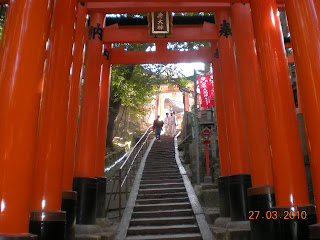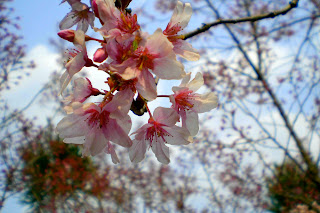To make the most out of this day, we left the capsule hotel at 6.30am. Indeed, this was one of the most tiring days in the entire trip.
Attraction #6: Fushimi-Inari Taisha (伏見稲荷大社)
One of the "not to be missed" attractions in southern Kyoto, this shrine draws many locals and foreigners alike. It was dedicated to the gods of rice and wine by the Hata family in the 8th century. Now, it is the head shrine for 30,000 Inari shrines all over in Japan. Our tip: Visit this shrine either at the hours following sunrise or the hours preceding sunset. The thousands of vermillion torii gates will appear several times more dazzling.
The 7am sun peeks through a torii gate
Folks praying at the main shrine. The bells hanging on the top are used as part of the praying ritual.
A wishing stick. I wrote "学業成就", which translates to "achievement in studies". Ya.. I am getting desperate as my 2nd upper is so near yet so far...
A two-foxes arch statue. Inari is the Shinto god of rice, and foxes are thought to be his messengers. Therefore, many fox statues like this can be found on the shrine grounds.
A paranomic view of downtown Kyoto city. (Northwards)
Kawaii!!!!
Fushimi-Inari Station, just a few minutes walk from the main entrance
Attraction #7: Kyoto International Manga Museum (京都国際漫画館)
Attraction #8: Nishiki Food Market (錦市場)
Famous for selling a wide variety of weird and delicious food, but unfortunately it doesn't go easy on your wallet. Located near the middle of central Kyoto, it is very accessible.
Franco eating his fried fritter.. yum yum!
Attraction #9: Kinkaku-ji (金閣寺)
Another one of the "die die must see" sights in Kyoto, this Golden Pavillon has its historical roots in the 14th century. However, the original was burnt down 60 years ago and what can be seen now is an exact replica. Be prepared to endure considerable compression in a sea of tourists when you visit this attraction. Going early in the day or just before the closing time can help alleviate the problem a little.
Attraction #10: Ryoan-ji (竜安寺)
The main attraction in this temple is the stone garden. It contains 15 rocks, apparently adrift in a sea of grey sand. The designer, who remains unknown, provided no explanation of this layout.
Attraction #11: Nijo Castle (二条城)
One of the "not to be missed" attractions in southern Kyoto, this shrine draws many locals and foreigners alike. It was dedicated to the gods of rice and wine by the Hata family in the 8th century. Now, it is the head shrine for 30,000 Inari shrines all over in Japan. Our tip: Visit this shrine either at the hours following sunrise or the hours preceding sunset. The thousands of vermillion torii gates will appear several times more dazzling.
The 7am sun peeks through a torii gate
Folks praying at the main shrine. The bells hanging on the top are used as part of the praying ritual.
A wishing stick. I wrote "学業成就", which translates to "achievement in studies". Ya.. I am getting desperate as my 2nd upper is so near yet so far...
A two-foxes arch statue. Inari is the Shinto god of rice, and foxes are thought to be his messengers. Therefore, many fox statues like this can be found on the shrine grounds.
A paranomic view of downtown Kyoto city. (Northwards)
Kawaii!!!!
Fushimi-Inari Station, just a few minutes walk from the main entrance
Attraction #7: Kyoto International Manga Museum (京都国際漫画館)
The very unfortunate thing here was, I couldn't take any photos inside the museum. But I managed to find some other photos of the museum's interior on the internet. This museum was erected in 2006 and houses some 300,000 manga collection. The museum is dedicated to introducing the art and the history of manga, all the way back to the Meiji era (A.D 1868 - 1912). Outside the main building lies a courtyard, where you can see otakus (anime/manga geeks) doing cosplay (putting on costumes to represent an anime/manga character).
Attraction #8: Nishiki Food Market (錦市場)
Famous for selling a wide variety of weird and delicious food, but unfortunately it doesn't go easy on your wallet. Located near the middle of central Kyoto, it is very accessible.
Franco eating his fried fritter.. yum yum!
Attraction #9: Kinkaku-ji (金閣寺)
Another one of the "die die must see" sights in Kyoto, this Golden Pavillon has its historical roots in the 14th century. However, the original was burnt down 60 years ago and what can be seen now is an exact replica. Be prepared to endure considerable compression in a sea of tourists when you visit this attraction. Going early in the day or just before the closing time can help alleviate the problem a little.
Attraction #10: Ryoan-ji (竜安寺)
The main attraction in this temple is the stone garden. It contains 15 rocks, apparently adrift in a sea of grey sand. The designer, who remains unknown, provided no explanation of this layout.
Attraction #11: Nijo Castle (二条城)
Quoted from Lonely Planet: This castle was built in 1603 as the official Kyoto residence of the first Tokugawa shogun, Ieyasu (徳川家康). The interior of the castle was supposedly fitted with 'nightingale floors', such that if an infiltrator or an assassin tries to walk across the floors, the floorboards would 'sing' like a nightingale!
Well, we didn't actually go inside the castle, but we did enter the castle grounds. And unlike the picture shown above (for illustration purposes only), we visited the castle at night =)
At about a month into the spring season, Nijo Castle is one of the cherry-blossom viewing hotspots - more so at night. Special lamps illuminate the Sakura trees that line up around the castle grounds.





















































































0 comments:
Post a Comment